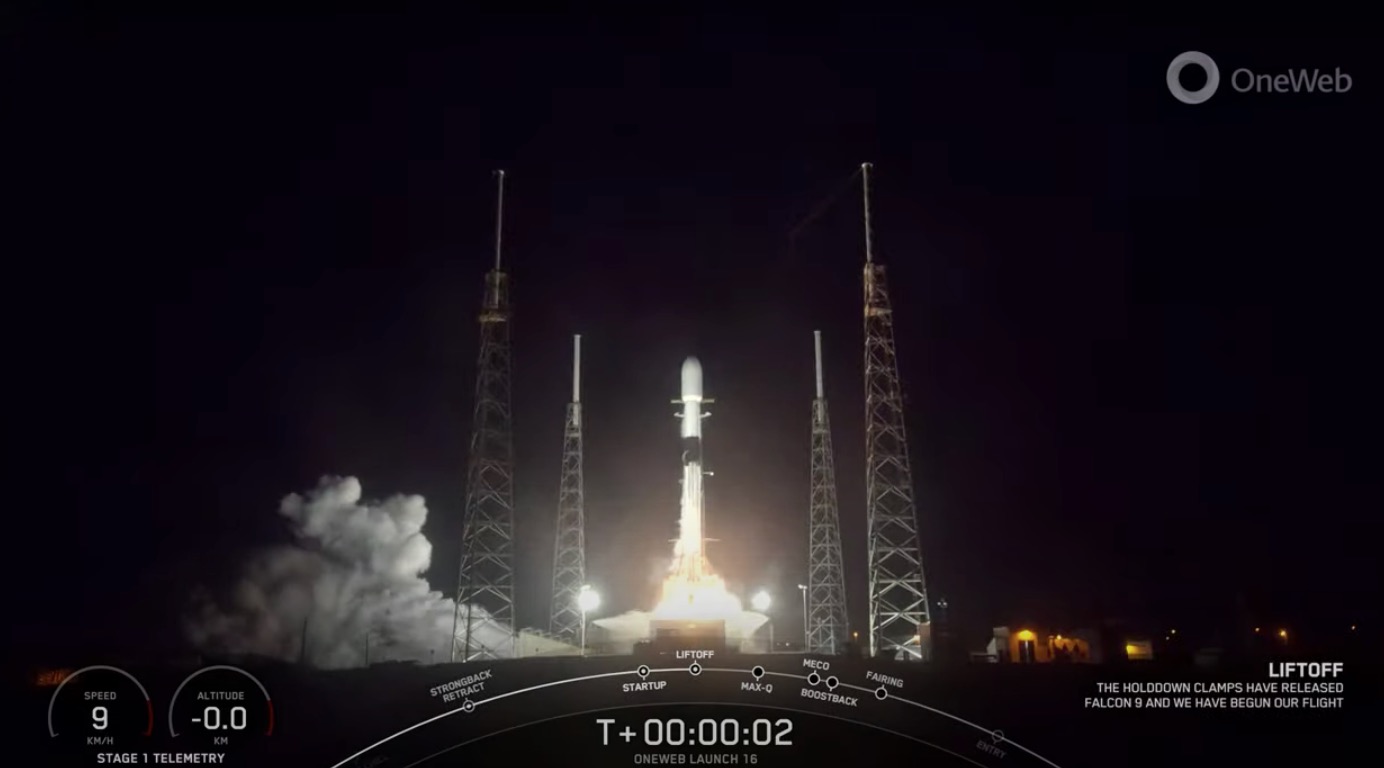SpaceX just launched another big batch of internet satellites for the communications company OneWeb.
A Falcon 9 rocket topped with 40 of OneWeb's broadband satellites lifted off from Cape Canaveral Space Force Station in Florida as planned on Monday at 11:50 p.m. EST (0450 GMT on Jan. 9).
The Falcon 9's first stage came back to Earth for a touchdown at Cape Canaveral's Landing Zone 1 about seven minutes and 45 seconds after launch. It was the second landing for this particular booster, which also launched SpaceX's robotic CRS-26 cargo mission to the International Space Station for NASA on Nov. 26 of last year.
The Falcon 9's upper stage, meanwhile, continued carrying the 40 OneWeb satellites to low Earth orbit. The spacecraft were deployed as planned over a roughly 37-minute span starting about 58 minutes after liftoff.
Related: 8 ways that SpaceX has transformed spaceflight

OneWeb is assembling a network of 648 satellites that will provide internet service to customers around the world. Before Monday night's mission, the London-based company had lofted 502 of those spacecraft, mostly aboard Russian-built Soyuz rockets operated by French outfit Arianespace.
But Russia's invasion of Ukraine in February 2022 put an end to the Russian partnership with Arianespace, forcing OneWeb to find other rocket rides. OneWeb did so, quickly signing launch deals with SpaceX and NewSpace India Limited (NSIL), the Indian Space Research Organisation's commercial arm.
Get the Space.com Newsletter
Breaking space news, the latest updates on rocket launches, skywatching events and more!
OneWeb has now flown twice with SpaceX and once with NSIL; 36 of its satellites went up on an Indian Launch Vehicle Mark-3 this past October, and a Falcon 9 lofted another 40 last month.
Monday was quite a busy day for SpaceX. The CRS-26 Dragon capsule departed the International Space on Monday afternoon, ending a six-week stay at the orbiting lab. The Dragon will splash down off the Florida coast on Wednesday (Jan. 11), if all goes according to plan.
The action will continue on Tuesday (Jan. 10) for SpaceX. The company plans to launch 51 of its own Starlink internet satellites from Vandenberg Space Force Base in California at 11:02 p.m. EST on Tuesday (0402 GMT on Jan. 11).
Editor's note: This story was updated on Jan. 8 with news of the new launch date of Jan. 9. The launch was originally targeted for the night of Jan. 8, but SpaceX pushed it back a day to finish prelaunch processing. It was updated again at 3:30 p.m. EST on Jan. 9 to include news of Monday's planned Starlink launch and the planned Monday departure of the Dragon cargo spacecraft. It was updated again at 12:10 a.m. EST on Jan. 10 with news of successful launch and rocket landing, then again at 1:40 a.m. EST with news of satellite deployment.
Mike Wall is the author of "Out There" (Grand Central Publishing, 2018; illustrated by Karl Tate), a book about the search for alien life. Follow him on Twitter @michaeldwall. Follow us on Twitter @Spacedotcom or on Facebook.
Join our Space Forums to keep talking space on the latest missions, night sky and more! And if you have a news tip, correction or comment, let us know at: community@space.com.

Michael Wall is a Senior Space Writer with Space.com and joined the team in 2010. He primarily covers exoplanets, spaceflight and military space, but has been known to dabble in the space art beat. His book about the search for alien life, "Out There," was published on Nov. 13, 2018. Before becoming a science writer, Michael worked as a herpetologist and wildlife biologist. He has a Ph.D. in evolutionary biology from the University of Sydney, Australia, a bachelor's degree from the University of Arizona, and a graduate certificate in science writing from the University of California, Santa Cruz. To find out what his latest project is, you can follow Michael on Twitter.









